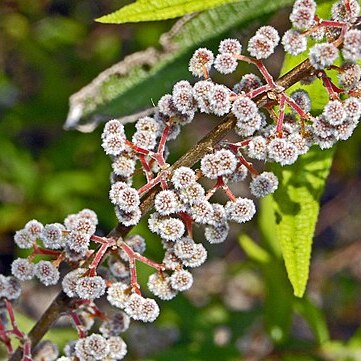Shrubs 1-4 m tall, often dioecious, rarely monoecious. Branchlets slender, branchlets and petioles dark reddish, often appressed pubescent or subglabrous. Stipules oblong-lanceolate, 6-8 mm, 2-cleft at apex; petiole 0.3-1 cm; leaf blade adaxially dark green, oblong-to linear-lanceolate, sometimes linear, 5-18(-25) × 1-2.5(-3.5) cm, papery or thinly so, 3-veined, lateral ones straight, reaching to middle, secondary veins 3-5 on each side from middle of leaf, anastomosing at margin, abaxial surface thinly greenish gray or gray-white tomentose, sparsely appressed pubescent on distinct veins, adaxial surface sparsely appressed strigose, often rugose, base rounded or broadly cuneate, margin finely serrulate or denticulate, apex acuminate. Inflorescences borne always on previous years’ branches, often flowering before leaf flush, 1-2-dichotomously branched or solitary, 0.5-1.5 cm; peduncle 0-1.5 cm, appressed pubescent; glomerules globose, 3-5 mm in diam.; bracts obovate, ca. 2 mm, membranous. Male flowers shortly pedicellate, oblate in bud, 1.2-1.5 mm in diam.; perianth lobes (3 or)4, triangular-ovate, sparsely puberulent abaxially, connate at base, apex acute; rudimentary ovary sessile, obovoid, ca. 0.5 mm. Female flowers sessile, obovoid, ca. 0.7 mm; perianth tube membranous, glabrous, 4-denticulate at apex. Achene orange, ca. 1 mm, enclosed by fleshy perianth and adnate to it. Fl. Feb-Apr, fr. May-Sep.
More
A shrub. It grows 1-4 m tall. The branches are slender. The leaf blade can be narrow and 5-18 cm long by 1-3 cm wide. There are 3 main veins. The flowers are produced on the previous years growth. Flowers can appear before the leaves. The male flowers have short stalks and the female flowers are without stalks. The fruit is a small dry single seed with a fleshy layer around it.

